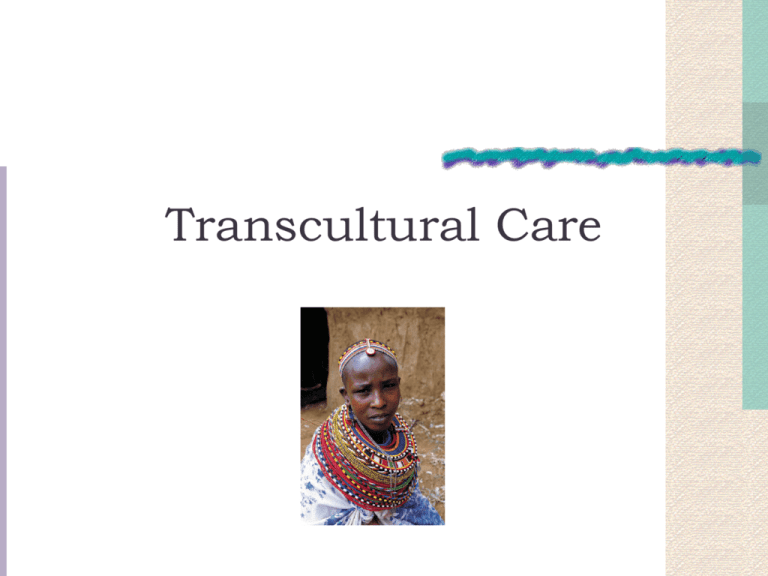Transcultural Care
advertisement

Transcultural Care Culture The shared values, traditions, norms, customs, arts, history, folklore, and institutions of a group of people that are unified by race, ethnicity, language, nationality, or religion. Source: Office of Minority and Women’s Health, HRSA, NIH Characteristics of Culture Learned roles, behaviors, values, attitudes Human nature, time, relationships, traditions Health beliefs, religion or spirituality Communication, decision-making, food/diet, grief/dying, family roles, sick roles. Characteristics of Culture Stabilizing forces and change agents Social Structure Family, politics, education, economics, art, history, physical environment, health care facilities, ethnicity Criteria for Defining Culture Common language/communica tion system Similarities in dietary preferences Common patterns of dress Predictable relationships and socialization patterns Shared values and beliefs Personal Culture Personality, unique structure Internal factors such as gender, age, sexual orientation External factors such as society, personal experiences Where one grows up or now lives With or without children, with or without religious affiliation Organizational/work influences Position within work place and its location Cultural Diversity Difference in Race, ethnicity, language, nationality, or religion among various groups within a community is said to be culturally diverse if its residents include members of different groups. Diversity Differences can be found in communities that are bounded by similarities in ethnicity, language, religion, geography, history or politics. Every interaction is cross-cultural! Ethnicity Identity one has based on ancestry and national, religious, tribal, linguistic or cultural origins. Sense of belonging to a reference group within a society Race Use of the term is debated Biological term used to categorize people based on physical characteristics Disregards genetic variations Often used in discriminatory manner Acculturation Giving up traits of one culture and adopting those of another Bicultural – function equally well in two cultures Traditional – retains traits from culture of origin Marginal – no traits from either culture or origin or new one in which he/she lives Acculturated – gives up traits of original culture and adopts those of new culture Assimilation Social, political, and economic integration of a cultural group into a mainstream society Usually requires a degree of acculturation Many cultural groups may resist or reject acculturation Communities develop in which people are insulated from main stream Lack of political voice may disadvantage group Ethnocentrism Viewpoint that one’s own way of believing or behaving is correct and preferred Ethnosensitivity Process of becoming more sensitive and respectful of cross cultural differences Cultural Competence A set of academic and interpersonal skills that allow individuals to increase their understanding and appreciation of cultural differences and similarities within, among, and between groups. This requires a willingness and ability to draw on community-based values, traditions, and customs and to work with knowledgeable persons of and from the community in developing targeted interventions, communications and other support. Source: Office of Minority and Women’s Health, HRSA, NIH 5 Elements of Cultural Competence Awareness and acceptance of differences Self-awareness or individual or organizational culture Understanding the dynamics of difference Integration of cultural knowledge within individuals and systems Adaptation to diversity Steps to Cultural Competence Awareness Becoming aware of other cultural viewpoints and taking into account the diversity in values, beliefs, practices, lifestyles and problem solving strategies Examination of one’s own culture, learned biases and prejudices Knowledge Learning about historical, social, political and/or religious influences that affect another’s worldview Distinguishing between an individual’s traits and those common to a community or people with similar origins Give and take of ideas and knowledge for effective interpersonal relationships Skills Integrating awareness and knowledge into western bio-medical system during a cross-cultural encounter to achieve “culturespecific, individualized interventions Collecting relevant cultural data in both a history and physical assessment Ability to generate conversation not confrontation Partnerships instead of misunderstandings Cultural Encounters Cross-cultural interactions that allow new learning or refinement of knowledge and beliefs Prevent stereotyping as the experience of interaction reveals intra-cultural group variation Medical Interpreters People who orally translates a message spoken in one language into another language People who are fluent in both languages People who are not relatives of the patient People who have received professional training Use of Interpreters Secure an interpreter for people who: Are non-English speaking Are limited English proficient Have limited understanding of health care issues in the English language Professional Interpreters VS Untrained Interpreters Professional interpreters have been screened to assure fluency in both languages Untrained interpreters may: Omit important information Add ideas Answer for the patient Give advice even if they don’t understand Family and Friends Used as Interpreters May commit all of the errors as other untrained interpreters May cause the patient to not feel comfortable sharing information May react to a situation or information rather than serve as an interpreter May make decisions for the patient There may be a breach of confidentiality Acceptable Interpreters Bilingual staff that is trained and demonstrates competence Contract interpreters Community volunteers who are competent interpreters Telephone interpreter services Working Effectively Through an Interpreter Conduct pre-session to introduce yourself and goals for the encounter Speak directly to the patient Speak slowly in short segments with pauses Ask that everything you and the patient and family says is interpreted Be aware there may not be linguistic equivalence for some terms Things to Avoid Highly idiomatic speech Complicated sentence structure Sentence fragments Changing an idea in mid-sentence Asking more than one question at a time Tips Have the interpreter ask questions and alert you to cultural misunderstandings Respect an interpreter’s opinion that a question may be culturally inappropriate Avoid patronizing or demeaning the patient Be patient as this may take more time Roles of the Interpreter Conduit of Information Clarifier: Facilitates understanding when no linguistic equivalence exists Culture Broker: Provides a cultural framework for understanding when cultural differences are leading to a misunderstanding Advocate: Actions to eliminate systematic barriers to quality care








